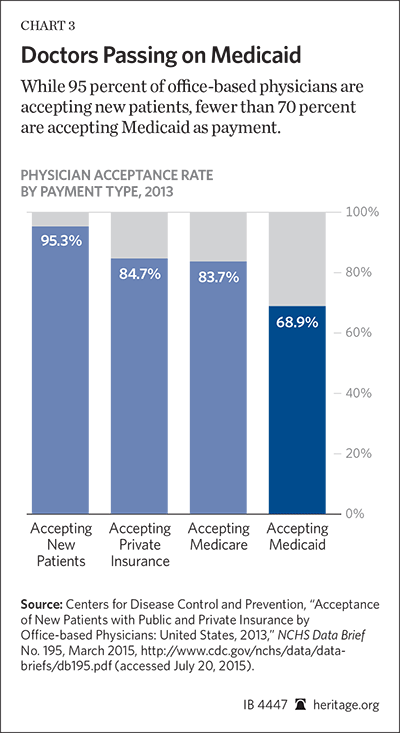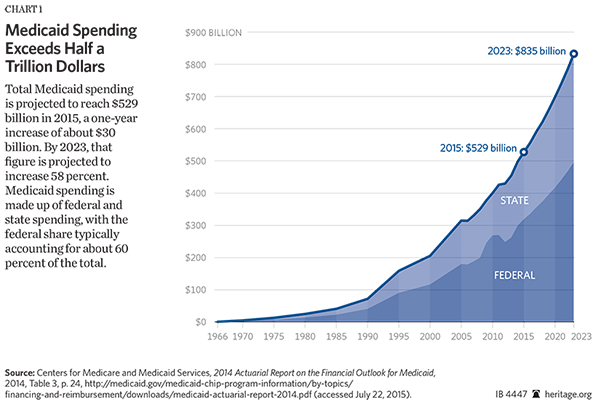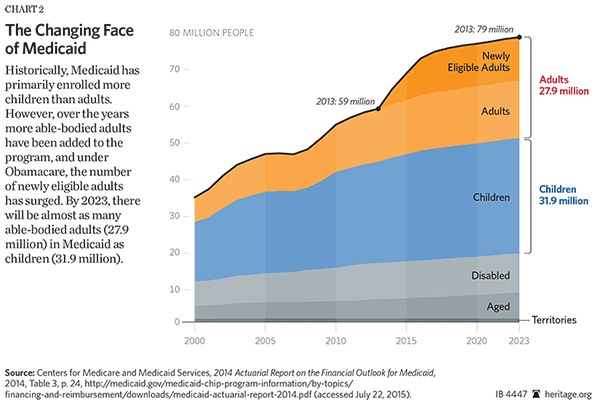Medicaid, enacted along with Medicare in 1965, was created to provide health care for certain categories of low-income Americans.[1] Over the past 50 years, the program has changed significantly. Not only has Medicaid eligibility expanded, so also has the scope of its care and services. Mounting fiscal, demographic, and structural challenges continue to strain the federal–state partnership on which Medicaid is based. These weaken the future of the program and those it was intended to serve.
Congress and the states must address these central problems. Congressional failure will come at the expense of both enrollees and the taxpayers. Looking ahead, Congress should seriously consider restructuring the program by injecting patient choice and genuine market competition into the program. These changes would better serve the poor and ensure that both federal and state taxpayers are also protected.
Fiscal Challenges
- Ballooning costs. Federal and state spending on Medicaid is skyrocketing. According to the Office of the Actuary at the Centers for Medicare and Medicaid Services (CMS), combined federal and state Medicaid spending has increased from $206.2 billion in 2000 to $529 billion projected for 2015.[2] By 2023, total spending will reach $835 billion, of which the federal share will be $497.4 billion, and the state share will be $337.5 billion.[3]
- Growing state dependence. The average federal matching rate for Medicaid is expected to increase as a result of additional federal funding put forth in the Affordable Care Act of 2010 (ACA, otherwise known as Obamacare). The average federal share will increase to 60 percent, up from 57 percent historically. While Medicaid is the largest budget item in state budgets, these federal funds account for a significant share of Medicaid state spending. For example, in fiscal year 2013, Medicaid was 24.5 percent of total state expenditures, yet the federal share represented 56.6 percent, whereas state general funds represented only 31.6 percent.[4] Thus, as Medicaid budgets grow, so do the federal dollars that come into the states.
- Fraud, waste, and abuse. Medicaid has a long history of fraud, waste, and abuse scandals. The CMS estimated $17.5 billion in improper payments in Medicaid for 2014.[5] The Government Accountability Office (GAO), in a recent report of four select states, “found thousands of Medicaid beneficiaries and hundreds of providers involved in potential improper or fraudulent payments during fiscal year 2011.”[6]
Demographic Challenges
- Shifting from children to adults. Medicaid has a diverse population base. Historically, Medicaid was a targeted program for certain categories of low-income individuals—children, pregnant women, the elderly, and the disabled. However, over time, policymakers in Washington and the state capitols have expanded eligibility by income and category. The most recent—and most dramatic—change came as a result of the ACA. Under the ACA, states have the option to expand coverage to more low-income, and able-bodied, individuals. As Chart 2 shows, this new expansion shifts Medicaid from a program that has predominately covered children, to a program that covers nearly as many able-bodied adults.
- An aging population. With the baby-boomer generation nearing retirement, and few of them financially prepared to assume the long-term care costs that are not paid for by Medicare, many of the elderly ultimately end up on Medicaid to cover their long-term-care needs, especially nursing home care. This shift has resulted in Medicaid becoming the default long-term-care option for America’s vast middle class. In 2013, this group, combined with the disabled, represented less than one-third of the program’s enrollment, but over 64 percent of Medicaid spending.[7]
Structural Challenges
- Less access to providers. Due in part to the time-consuming and burdensome reimbursement process, as well as the low reimbursement levels, many physicians—general and specialist—refuse to accept Medicaid patients. On average, Medicaid pays physicians about 66 percent of what Medicare pays.[8] A recent study by the Centers for Disease Control found only 68.9 percent of physicians would accept a new Medicaid patient.[9]

- Lower quality of care. Medicaid also has a record of providing patients with worse outcomes than those of privately insured patients. A recent and fairly comprehensive literature review found that, in addition to having less access to specialists, Medicaid patients had longer hospital stays and higher mortality rates in certain instances.[10]
- Slow to change. Medicaid is a joint federal–state program. The federal government imposes certain rules and regulations governing the administration of Medicaid, but beyond that, states have some latitude. For example, the federal government distinguishes between mandatory and optional populations and services that a state either must or could provide. Within that regulatory context, many states have pursued waiver options within the program, which must be negotiated with the Secretary of Health and Human Services for approval. Such waivers are, however, a sluggish way of changing the underlying health policy. This time-consuming process is cumbersome and leads to further tensions between the states and federal government over the administration of the program.
Looking Ahead
After 50 years, Medicaid needs an overhaul. By enacting the ACA, Congress bypassed any real reform to Medicaid and simply adds new enrollees to this already overburdened program.
Congress needs to reform Medicaid—but Medicaid reform should not be another excuse to create a lifetime of dependence, but to support independence. Reform should assist those who are able to shift to a competitive private health insurance market, where coverage is more affordable and thus the need for assistance diminishes.[11] For the disabled and elderly, reform should be more accountable to the patients by giving them greater choice and allowing for more patient-centered options, including private-sector options, especially in accessing long-term care. Finally, Medicaid must be put on a real budget, like other federal programs, to rein in spending and protect taxpayers from runaway spending. These reforms will help to ensure that Medicaid does not drift further from its core mission, and remains committed to preserving a safety net, and protecting taxpayers as well.
—Nina Owcharenko is Director of the Center for Health Policy Studies and Preston A. Wells, Jr., Fellow, of the Institute for Family, Community, and Opportunity, at The Heritage Foundation.





